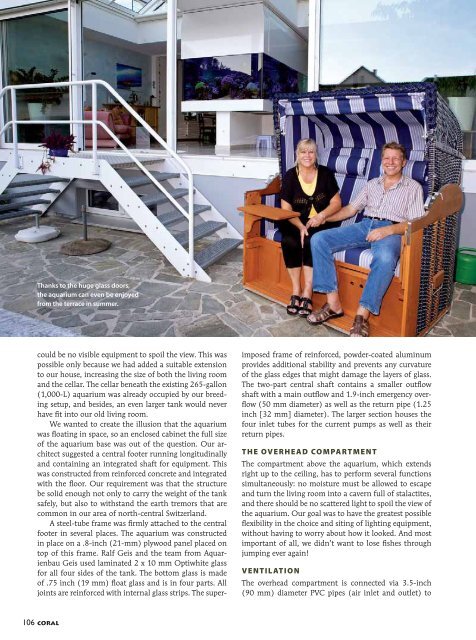Create successful ePaper yourself
Turn your PDF publications into a flip-book with our unique Google optimized e-Paper software.
Thanks to the huge glass doors,<br />
the aquarium can even be enjoyed<br />
from the terrace in summer.<br />
could be no visible equipment to spoil the view. This was<br />
possible only because we had added a suitable extension<br />
to our house, increasing the size of both the living room<br />
and the cellar. The cellar beneath the existing 265-gallon<br />
(1,000-L) aquarium was already occupied by our breeding<br />
setup, and besides, an even larger tank would never<br />
have fit into our old living room.<br />
We wanted to create the illusion that the aquarium<br />
was floating in space, so an enclosed cabinet the full size<br />
of the aquarium base was out of the question. Our architect<br />
suggested a central footer running longitudinally<br />
and containing an integrated shaft for equipment. This<br />
was constructed from reinforced concrete and integrated<br />
with the floor. Our requirement was that the structure<br />
be solid enough not only to carry the weight of the tank<br />
safely, but also to withstand the earth tremors that are<br />
common in our area of north-central Switzerland.<br />
A steel-tube frame was firmly attached to the central<br />
footer in several places. The aquarium was constructed<br />
in place on a .8-inch (21-mm) plywood panel placed on<br />
top of this frame. Ralf Geis and the team from Aquarienbau<br />
Geis used laminated 2 x 10 mm Optiwhite glass<br />
for all four sides of the tank. The bottom glass is made<br />
of .75 inch (19 mm) float glass and is in four parts. All<br />
joints are reinforced with internal glass strips. The superimposed<br />
frame of reinforced, powder-coated aluminum<br />
provides additional stability and prevents any curvature<br />
of the glass edges that might damage the layers of glass.<br />
The two-part central shaft contains a smaller outflow<br />
shaft with a main outflow and 1.9-inch emergency overflow<br />
(50 mm diameter) as well as the return pipe (1.25<br />
inch [32 mm] diameter). The larger section houses the<br />
four inlet tubes for the current pumps as well as their<br />
return pipes.<br />
THE OVERHEAD COMPARTMENT<br />
The compartment above the aquarium, which extends<br />
right up to the ceiling, has to perform several functions<br />
simultaneously: no moisture must be allowed to escape<br />
and turn the living room into a cavern full of stalactites,<br />
and there should be no scattered light to spoil the view of<br />
the aquarium. Our goal was to have the greatest possible<br />
flexibility in the choice and siting of lighting equipment,<br />
without having to worry about how it looked. And most<br />
important of all, we didn’t want to lose fishes through<br />
jumping ever again!<br />
VENTILATION<br />
The overhead compartment is connected via 3.5-inch<br />
(90 mm) diameter PVC pipes (air inlet and outlet) to<br />
106 CORAL

















